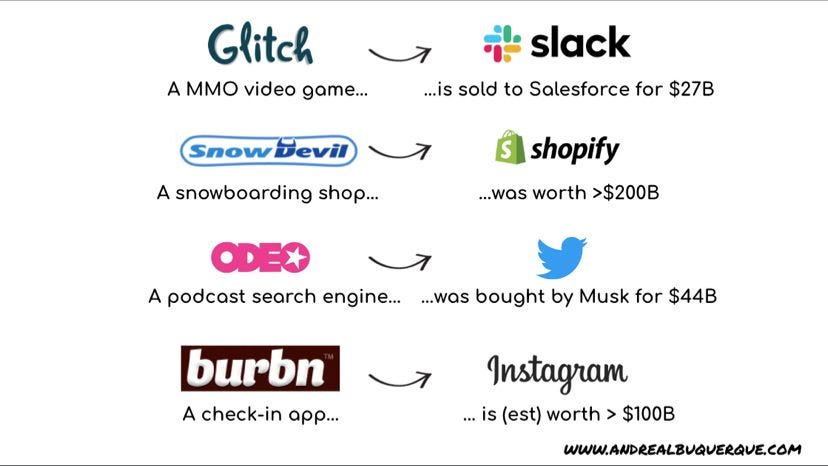
Article 5. The Art of Pivoting: Knowing When to Change Course
Should a startup change direction if needed?
If so, when is the right time?
And how do you identify between a rough patch vs. a dead end?
You already know that having a great idea is only part of the equation (Article 1). And while building a solid business model is critical to turning that idea into something real (Article 4), even the most thoughtful plans can run into obstacles.
This is where the art of pivoting comes in.
Knowing when and how to pivot isn’t just a survival tactic — it’s often what separates the startups that scale from those that stall. The ability to change course when your original strategy isn’t delivering results isn’t a weakness; it’s a strength.
It’s a mindset rooted in adaptability, awareness, and action.
So let’s get into it: why pivoting matters, when to do it, and how to do it well.
Successful Pivots. Startups That Found Success by Changing Course
Instagram. The Photo-Sharing App That Became a Billion-Dollar Business
The Situation:
Instagram didn’t start as the photo-sharing giant we know today. It began as Burbn, a location-based check-in app similar to Foursquare. However, the team quickly noticed that users were far more interested in the photo-sharing feature.
The Pivot:
Rather than pushing forward with a location-based app, the founders of Instagram shifted focus entirely to photo-sharing. They simplified the app, emphasizing visual content, social interactions, and mobile-first design.
Key Elements:
- Simplicity: Instagram’s clean, user-friendly interface made it easy for users to share photos.
- Social Interaction: The app was built to encourage engagement and interaction.
- Mobile Focus: The team capitalized on the rise of mobile-first social networking.
The Outcome:
Instagram’s pivot was a massive success. In just two years, the app gained millions of users and was acquired by Facebook for $1 billion in 2012. Today, Instagram boasts over 2 billion monthly active users and remains a dominant player in social media.
Slack: From Gaming Platform to Communication Powerhouse
The Situation:
Slack’s story begins with Tiny Speck, a gaming company that created an online game called Glitch. Despite early acclaim, Glitch was unsuccessful commercially, forcing the company to shut down.
The Pivot:
Rather than abandoning their tech, the Tiny Speck team realized that the internal communication tool they had developed for the game’s development could have significant potential in the corporate world. They pivoted to create Slack, a messaging platform designed to help teams communicate and collaborate more effectively.
Key Elements:
- Solving a Real Pain Point: Slack addressed the issue of disorganized team communication.
- User-Centric Development: The platform was built to be simple, intuitive, and powerful for team collaboration.
- Adaptation to Market Needs: The founders listened to feedback and continuously refined the product to meet business demands.
The Outcome:
Today, Slack is worth $27 billion and has transformed how teams communicate. With over 12 million daily active users, it’s used by major companies like Google, IBM, and Airbnb.
Netflix: From DVD Rentals to Streaming Giant
The Situation:
Netflix began in 1998 as a DVD rental-by-mail service, competing against heavyweights like Blockbuster. As video streaming technology began to emerge, Netflix saw a new opportunity.
The Pivot:
Netflix made a bold decision to transition from DVD rentals to streaming. As broadband internet expanded, Netflix embraced the future by offering unlimited digital subscriptions. Additionally, they ventured into producing original content, setting them apart from competitors.
Key Elements:
- Embracing Technology: Netflix capitalized on the growing trend of digital streaming and the availability of high-speed internet.
- Innovative Content Model: They pioneered original content production, attracting new subscribers.
- Global Expansion: Netflix expanded to over 190 countries, making streaming accessible worldwide.
The Outcome:
Netflix is now valued at over $200 billion, with more than 220 million subscribers. The company has completely redefined how we consume entertainment.
What Is a Pivot, Really?
At its core, a pivot is a fundamental shift in your business strategy, typically driven by new data, customer feedback, or market conditions. It could involve changing your target audience, adjusting your product offering, or completely rethinking how you deliver value.
Pivoting doesn’t mean giving up on your startup — it means you’re adapting to meet the market’s demands, just like any other resilient entrepreneur should. The key is knowing when to make that change before your startup runs out of steam.
Signs Your Startup Might Need a Pivot

Before you make any drastic decisions, it’s important to recognize the signs that a pivot might be necessary. Here are a few red flags that it might be time to change course:
- You’re Not Achieving Product-Market Fit
If your product isn’t solving a problem for the right people, it will be difficult to scale. Signs to watch for include low customer engagement, poor retention, and a lack of demand. - Customer Feedback Isn’t Aligning with Your Vision
Your customers’ feedback is vital. If your users are telling you that your product isn’t meeting their needs or is difficult to use, it may be time to pivot. Negative reviews, abandoned purchases, or features that no one uses are all red flags. - Your Business Model Isn’t Sustainable
If your business model isn’t generating enough revenue or your costs are spiraling, it could indicate that a pivot is needed. You might need to adjust your pricing model, target a different customer segment, or explore new revenue streams. - You’re Facing Unexpected Competition
If a competitor emerges with a better offering or a more efficient model, it’s crucial to adapt. Failing to stay competitive could lead to loss of market share.
When Pivoting Doesn’t Work. What Happens When You Wait Too Long
Pivoting is essential, but it’s important to recognize when you’ve waited too long. Here are two companies that failed to pivot—or waited too late:
- Quibi: A Streaming Service That Couldn’t Find Its Niche
Quibi launched in 2020 as a mobile-first streaming platform designed for short-form content. Despite a $1.75 billion investment, Quibi failed to resonate with its audience. Users weren’t interested in paying for short-form video when free alternatives like YouTube were available. The service was launched just as the pandemic hit, shifting consumer attention towards long-form content.
Outcome: Quibi shut down within six months, illustrating that failing to align with market trends can result in quick failure. - Yahoo: A Company That Missed the Shift to Mobile
Yahoo was once a dominant force on the web but failed to adapt quickly to the mobile-first revolution. While companies like Google and Facebook embraced mobile development, Yahoo stuck with its desktop-first approach.
Outcome: Yahoo was acquired by Verizon for a fraction of its peak value, showing that failure to pivot can lead to irrelevance.
How to Pivot Effectively

Now that we know why pivoting is necessary, along with some successful examples, let’s talk about how to pivot effectively. It’s not just about changing direction — it’s about doing so strategically and deliberately.
- Listen to Your Customers
The best pivots come from listening to your customers’ needs. Use customer feedback, surveys, and user testing to gather data. The more insight you have into their pain points, the better you can adjust your offering. - Stay Focused on Your Vision
A pivot doesn’t mean abandoning your overall mission. In fact, it’s about aligning your new direction with your core vision. Your goal may still be the same — it’s just the approach that changes. - Test Small, Then Scale
When you decide to pivot, don’t dive in headfirst. Test your new approach on a small scale first. If it works, then scale it. Rapid prototyping and A/B testing are invaluable tools in this process. - Communicate the Pivot to Your Team
Your team needs to understand why the pivot is happening. Be transparent about the reasons and ensure everyone is on board with the new direction. If your team understands the why, they’ll be more motivated to execute the new plan effectively.
Pivoting Isn’t a Sign of Failure — It’s a Sign of Growth
It’s a hard truth. Startups won’t always follow the path you originally envisioned. And that’s okay. Pivoting is a natural part of the startup journey, and it’s something you’ll likely have to do multiple times before you find the right formula for success.
In fact, as we explored in Article 3, knowing when to stop chasing an unrealistic dream is just as important as knowing when to make a change. Pivoting doesn’t mean giving up — it means you’re listening, adapting, and finding smarter ways to succeed.
Conclusion: Key Takeaways on Pivoting

- Pivoting is a strategic response, not a sign of failure
It’s about recognizing when something isn’t working and having the courage to make a change. - Successful pivots are driven by insight
The best pivots come from listening to customer feedback, analyzing market trends, and identifying new opportunities. - Timing matters
Waiting too long to pivot can lead to missed opportunities or failure — the sooner you recognize the need for change, the better. - Stay anchored to your core mission
While your approach may evolve, your startup’s vision should remain consistent. Pivoting is about adapting the how, not the why. - Test and iterate before scaling
A smart pivot starts with small experiments. Gather feedback, make adjustments, and scale only when you’ve validated the new direction. - Keep your team aligned
Clear communication and shared understanding are critical during a pivot. Everyone should know the reasons behind the shift and how their role contributes.
Remember: The ability to pivot is the ability to grow. Stay flexible, stay focused, and keep adapting.
The Next Step
In the upcoming articles, we’ll look at The Role of Resilience in Startup Success (Article 6) and Team Dynamics and Leadership in Startups (final article). Both are key to ensuring that your startup doesn’t just survive — it thrives.
After all, resilience and leadership will keep you steady in the face of change.
Ready to Turn Your Idea into a Scalable Success?
Building a strong business model can be challenging, but you don’t have to do it alone. At CXO Sweden, we specialize in helping startups like yours design and implement business models that drive sustainable growth and long-term success. If you’re ready to move beyond the idea phase and build a model that works, let us guide you through the process.
Contact us, and let’s turn your vision into a thriving business together.



